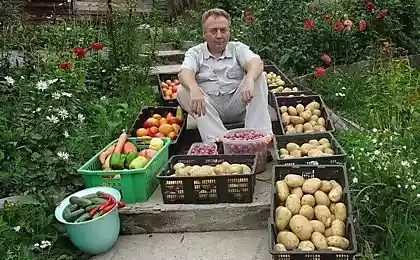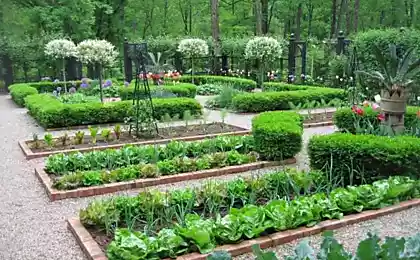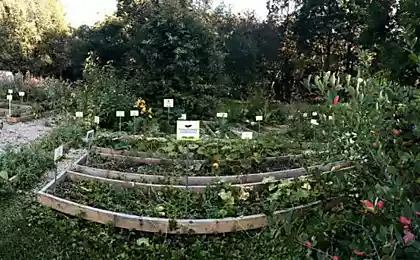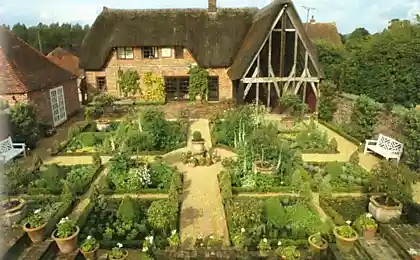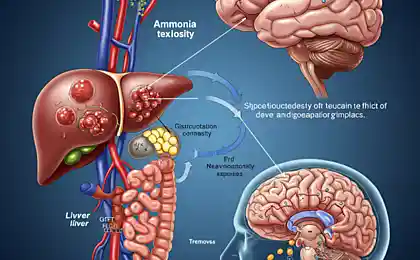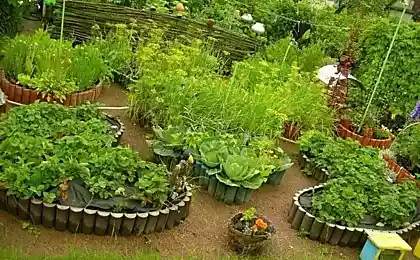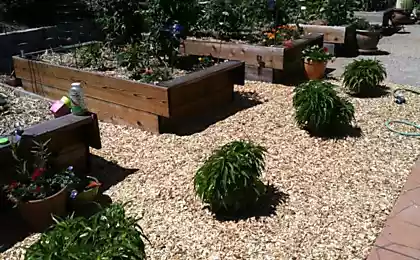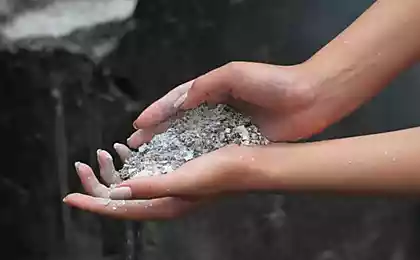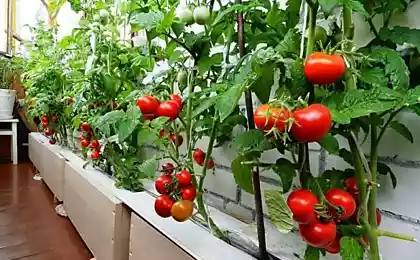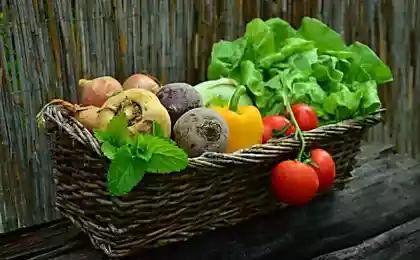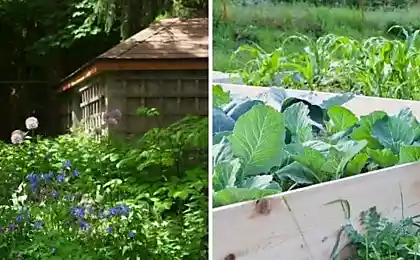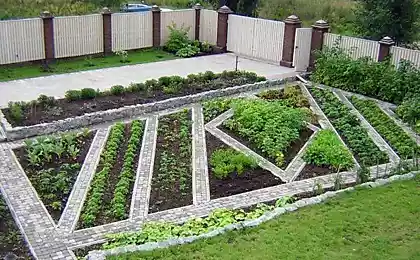711
How to get a bumper crop —PODKORMIKI for Your vegetable garden from Igor Liadov
Every farmer could prepare microbial preparations, almost as diverse as selling culture, EM (effective microorganisms), but from their local, adapted to the climate and soil of germs that will be more environmentally competent and practical.
Try practical, simple and cheap ways to restore soil fertility and increase yields of plants.
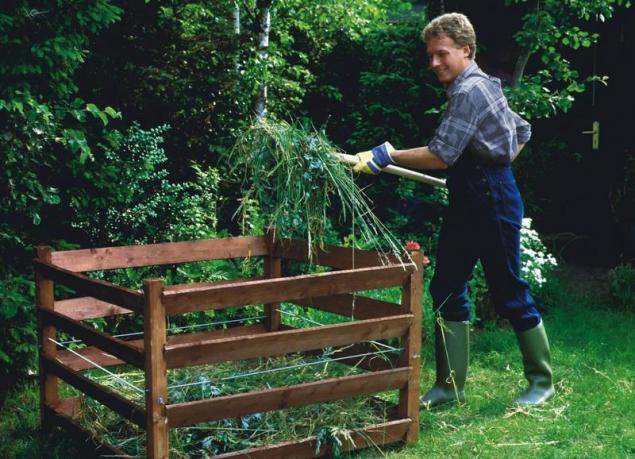
1. Given that the main component of EM are yeast and lactic acid bacteria, which are already in the soil and around us, we offer as a starter of organic infusions to use regular sugar-yeast mash.
Prepare infusion. 200-liter capacity (a barrel) put:
— shovel of wood ash or herbal;
— half a bucket of manure or litter;
bucket rotten straw or leaf litter;
— shovel humus, compost or just garden soil;
— a shovel of sand;
liter whey or yogurt;
— 3 liters of brew.
Mash prepared as follows:
3 liters of not chlorinated water is taken 5 tablespoons of sugar and a pinch of yeast. Haunting 2-3 days, then added in a common tank. To use to keep the mash should be refrigerated — it is valuable, not yet soured.
In General, the tank whole thing was infused for weeks. Sometimes it should be stirred. When using infusion diluted in no less than two times.
2. 200 liter barrel laying salnikovoy grass 2/3 of the barrel (you can add 2 ash shovels). Fill with water, cover with foil on top. Infused for two weeks.
If you use the tincture dilute 1 to 10.
3. 200 liter barrel laying fresh manure, 1/3 of the barrel. Fill it with water. Infused for two weeks.
If you use the tincture dilute 1 to 10.
4. 200 liter barrel laying chicken manure, 1/3 of the barrel. Fill it with water. Infused for two weeks.
If you use the tincture dilute 20 to 1.
Fertilizer... weeds: how to prepare liquid fertilizer
This fertilizer is a godsend for the gardener. Out of nothing (weeds!) to make a organic fertilizer, is equivalent to the composition of manure. You need only three components: water, grass and a bit of any nitrogen fertilizer to enhance fermentation. The most attractive thing for us – that only one barrel of 200 liters in summer produces huge quantities of fertilizers, so that a regular garden plot of a few acres powered fully.
How to make liquid fertilizer
Required plastic container, preferably ample, from 50 years, the best – normal barrel 200 l, but will fit and buckets. Importantly, the capacity was plastic, not iron.
Best haunting of the green vegetable mass, so as the main raw material for production of fertilizers are usually used mowed grass, weeds, tops.
The barrel cover them as long as there is half or two-thirds, or even completely. The more grass, the more dense fertilizer to happen.
Then add a nitrogen source to enhance fermentation: nitrogen is part of the protein, the bacteria multiply rapidly in the presence of nitrogen (in the tissue little nitrogen, bacteria decompose it slowly). The source of nitrogen can be:
After that, pour water almost to the brim.
The top barrel cover with lid or knotted polyethylene.
The first batch of fertilizer is prepared in about two weeks — a little longer than all subsequent (7-10 days).
Before the use should stir the ground herb in a barrel, so that it washed away as many particles of the substance decomposed, grass, remove with a fork and use to mulch cucumbers, pumpkins, cabbage, etc., and a liquid solution to use for fertilizing. But not all: there are plenty of microorganisms, so a couple of buckets should be left at the bottom of the barrel for "leaven" the next batch of grass.
Then fill the barrel the accumulated weeds, add a source of nitrogen, pour water and everything is repeated.
In the hot summer, when the fermentation goes quickly, fertilizer is matured for 7-10 days.
The advantages of liquid fertilizer
Such "pros" as many as three.
First, we are under the plant absorbed nitrogen fertilizer in the form of a solution — it works much faster than mulch of rotting grass.
Secondly, eliminate soil acidity due to the alkaline reaction of the solution (also faster than a dry making deoxidizers).
Thirdly, saturate the land of the living active microorganisms, the selection of which possess protective action. That is, it is both a food and improving the environment, and protection from many diseases.
In addition, this liquid very well watered the pure land in the early preparations for the landing.
In short, a barrel of herbal liquid fertilizer in the summer is the main "figure" in the care of the plantings. Set it in the middle of the plantings, so you don't have far to carry the dressing.
It is necessary to note another valuable feature barrels of fermenting grass – it works as a disinfectant device. It is possible to throw the "for processing" affected by any diseases of the foliage, which would otherwise have to burn. In a barrel of anaerobic conditions, there will not survive any single agent – all will turn into fertilizer. In addition, the barrel may pour the ground – fallen fruit of apples, currants, gooseberries, which are supposed to bury deeply or burn. Thus, a barrel of fertilizer eliminates the need all summer to build fires and dig holes. Convenient!
If the fertilizer?
When the fertilizer is ready, the contents of the barrel there is the smell of "barn", the color becomes similar to the manure slurry: greenish-dirty, herbal weight much bubbling is carbon dioxide. Once there is bubbling, so fermentation is definitely going well, the grass decomposes, and produces carbon dioxide and ammonia. We are very at hand, that the ammonia is in the water and connect it with the formation of ammonia, and does not escape as if it were manure or compost.
Ammonia has an alkaline reaction, which is very beneficial in acidic soils. In addition, since the ammonium ion is positively charged, it is well fixed in the clay soil, where particles are on the surface negative charge (opposite charges attract). Therefore, the liquid contents of the barrel, like all organic fertilizers, you can make the fall into the soil: nitrogen is washed out a little.
In what proportions to dilute and when to make
So, we got the universal nutrient solution, which can be used as basic fertilizer, making it in the preparation of the soil, and as a summer dressing.
I dilute the fertilizer is usually "the eye" — 1:1(1,5), i.e. 200 litres of liquid fertilizer obtained 400-500 l feeding through a week – even half a ton!
The volume of feedings depend on the needs of individual cultures. So, if for cabbage and cucumbers in August, you can pour a bucket of diluted feeding under a Bush, for strawberries – 1-2 liters per shrub. Be aware that fertilizing with nitrogen is if you overdo it, it can cause unwanted excessive growth of foliage (tomatoes, strawberries), or to provoke the occurrence of pests and diseases. Balance on the middle.
In August and autumn production of fertilizer is not terminated, the benefit in addition to weeds there are many cut tops, and let him go in. Useful vengeance to pour fertilizer all ready to spring clean pieces of land.
And the plants themselves, — is it possible to water this fertilizer in the fall the plants themselves? Here caution! As you know, trees and shrubs in late summer nitrogen is not fed. Pour this fertilizer tree trunks circles in perennial plants only in the late autumn, when the plants dropped leaves and fully prepared for winter! Otherwise, our fertilizer containing nitrogen, can delay the growth of the branches and cause the poor winter hardiness of the branches.
It turns out that for three summer months with the help of one barrel can be sent to the site 6 t of dressing. I think this site will remain without a crop? What do you think, how many kilograms of premium plant products can you get?
How long can you store liquid fertilizer
Who taught biology, he knows that ammonia in high concentrations is a poison to all living things (which is why breeders are so carefully remove litter from cages!). In particular, for micro-organisms. When in the barrel builds up too much ammonia, the microbes die: poisoned by its own secretions.
After standing a month, the solution will still be nutritious, but without the germs. So, if you want to water the soil alive with microbes, if you want to have was a continuous live production of fertilizers, you need not only to continually add fresh food for the microbes, but also in a timely manner to remove ripened muck.
Herbal fertilizer does best in acidic soils, because it is the ammonia (alkaline) and is able to quickly improve the environment in the rooting zone is thicker in addition to power. On neutral soils in this special need, you can settle for humus manure or compost, and as mulch. Although neutral soils herbal fertilizer works great as a nitrogen source because of its alkaline effect is not so strong, not stronger than manure.
And what about the incomplete decomposition is not a disadvantage (it "organists" thinking, our zealous proponents of organic agriculture), because herbal fertilizer in a barrel repeats the processes in the rumen of the cow under anaerobic conditions (so this barrel has the silage smell of the barn), fresh manure consists of decay products, including ammonia, and after making the soil collapse ends, it turns out the fertilizer.
Similarly, the freshly prepared herbal fertilizer in the soil then successfully completes the collapse. It only has to be diluted with water 3-5 times, otherwise the ammonia can actually poison the plants. Gamatie and liquid fertilizers generally consist of ammonia and still give an excellent return (on acid soils), because the ion (NH4)+ is the most that neither is a "soil" ion.
A barrel with grass fertilizer is very useful in the garden because you can quickly, within weeks, turned into fertilizer all in the compost decomposes over the years: sick leaves with any infection and pests (snails can crawl out, no one there don't leave alive!), roots, sod, weeds with seeds, and mowed weeds with the seeds — all this can be put in a barrel to the top, cover with water and add a little nitrogenous fertilizer (manure), all this during the week zabrasive and pants, all rhizomes and seeds are killed (biologists know that from higher organisms in these conditions can only survive ciliate slipper, and the concentration of ammonia in the end kills) — we just have to turn the barrel to dump this mass of "half-life" and then post it "on the field" that is, the beds that we are preparing already for next year will be a good fertilizer.
Fertilize with nitrogen in the fall for overwintering perennials is not only possible, but necessary. Because the plants in the spring is the best start when they are still in the autumn or winter the roots felt nitrogen. I have noticed that the fall fertilizer gives good results, especially on early blooming crops (tulips, garlic, currants, raspberries, etc.).
By the way, in V. Zabotina on root systems of Apple trees, the author writes that after Apple passed the September period of the growth of young roots of the tree better if these young roots immediately retracted the nitrogen, so he even insists that in the second half of the autumn to feed Apple trees with urea: then they better overwinter and then grow stronger and produce fruit.
It is important to make nitrogen fertilizer before the Oct. And in October, because of the cold nights the plants at all desire will not go in strong growth. A slight increase, for example, bulbous, not terrible. And the strawberry nitrogen uneasy in General will only benefit.
Fear of nitrogen leaching the melt with water is not necessary: firstly, he has never and will never washed out, the soil is at least 40-50% delay in humus, even sandy and clay — all 60-70%, especially amonini nitrogen, not nitrate. Secondly, the use of nitrogen will affect autumn, when the plant part it is used and will stock up for the spring.published
Author: Paul Tranoy
P. S. And remember, only by changing their consumption — together we change the world! ©
Join us in Facebook , Vkontakte, Odnoklassniki
Source: www.liveinternet.ru/tags/%CF%EE%E4%EA%EE%F0%EC%EA%E8+%E4%EB%FF+%E2%E0%F8%E5%E3%EE+%EE%E3%EE%F0%EE%E4%E0+%EE%F2+%C8%E3%EE%F0%FF+%CB%FF%E4%EE%E2%E0/
Try practical, simple and cheap ways to restore soil fertility and increase yields of plants.

1. Given that the main component of EM are yeast and lactic acid bacteria, which are already in the soil and around us, we offer as a starter of organic infusions to use regular sugar-yeast mash.
Prepare infusion. 200-liter capacity (a barrel) put:
— shovel of wood ash or herbal;
— half a bucket of manure or litter;
bucket rotten straw or leaf litter;
— shovel humus, compost or just garden soil;
— a shovel of sand;
liter whey or yogurt;
— 3 liters of brew.
Mash prepared as follows:
3 liters of not chlorinated water is taken 5 tablespoons of sugar and a pinch of yeast. Haunting 2-3 days, then added in a common tank. To use to keep the mash should be refrigerated — it is valuable, not yet soured.
In General, the tank whole thing was infused for weeks. Sometimes it should be stirred. When using infusion diluted in no less than two times.
2. 200 liter barrel laying salnikovoy grass 2/3 of the barrel (you can add 2 ash shovels). Fill with water, cover with foil on top. Infused for two weeks.
If you use the tincture dilute 1 to 10.
3. 200 liter barrel laying fresh manure, 1/3 of the barrel. Fill it with water. Infused for two weeks.
If you use the tincture dilute 1 to 10.
4. 200 liter barrel laying chicken manure, 1/3 of the barrel. Fill it with water. Infused for two weeks.
If you use the tincture dilute 20 to 1.
Fertilizer... weeds: how to prepare liquid fertilizer
This fertilizer is a godsend for the gardener. Out of nothing (weeds!) to make a organic fertilizer, is equivalent to the composition of manure. You need only three components: water, grass and a bit of any nitrogen fertilizer to enhance fermentation. The most attractive thing for us – that only one barrel of 200 liters in summer produces huge quantities of fertilizers, so that a regular garden plot of a few acres powered fully.
How to make liquid fertilizer
Required plastic container, preferably ample, from 50 years, the best – normal barrel 200 l, but will fit and buckets. Importantly, the capacity was plastic, not iron.
Best haunting of the green vegetable mass, so as the main raw material for production of fertilizers are usually used mowed grass, weeds, tops.
The barrel cover them as long as there is half or two-thirds, or even completely. The more grass, the more dense fertilizer to happen.
Then add a nitrogen source to enhance fermentation: nitrogen is part of the protein, the bacteria multiply rapidly in the presence of nitrogen (in the tissue little nitrogen, bacteria decompose it slowly). The source of nitrogen can be:
- waste toilet (in small amounts – 1 to 3 liters per barrel);
- tablespoon of urea (urea) – a well-known granulated mineral fertilizers;
- a few caps gumanova liquid fertilizers (black and smelling of ammonia).
After that, pour water almost to the brim.
The top barrel cover with lid or knotted polyethylene.
The first batch of fertilizer is prepared in about two weeks — a little longer than all subsequent (7-10 days).
Before the use should stir the ground herb in a barrel, so that it washed away as many particles of the substance decomposed, grass, remove with a fork and use to mulch cucumbers, pumpkins, cabbage, etc., and a liquid solution to use for fertilizing. But not all: there are plenty of microorganisms, so a couple of buckets should be left at the bottom of the barrel for "leaven" the next batch of grass.
Then fill the barrel the accumulated weeds, add a source of nitrogen, pour water and everything is repeated.
In the hot summer, when the fermentation goes quickly, fertilizer is matured for 7-10 days.
The advantages of liquid fertilizer
Such "pros" as many as three.
First, we are under the plant absorbed nitrogen fertilizer in the form of a solution — it works much faster than mulch of rotting grass.
Secondly, eliminate soil acidity due to the alkaline reaction of the solution (also faster than a dry making deoxidizers).
Thirdly, saturate the land of the living active microorganisms, the selection of which possess protective action. That is, it is both a food and improving the environment, and protection from many diseases.
In addition, this liquid very well watered the pure land in the early preparations for the landing.
In short, a barrel of herbal liquid fertilizer in the summer is the main "figure" in the care of the plantings. Set it in the middle of the plantings, so you don't have far to carry the dressing.
It is necessary to note another valuable feature barrels of fermenting grass – it works as a disinfectant device. It is possible to throw the "for processing" affected by any diseases of the foliage, which would otherwise have to burn. In a barrel of anaerobic conditions, there will not survive any single agent – all will turn into fertilizer. In addition, the barrel may pour the ground – fallen fruit of apples, currants, gooseberries, which are supposed to bury deeply or burn. Thus, a barrel of fertilizer eliminates the need all summer to build fires and dig holes. Convenient!
If the fertilizer?
When the fertilizer is ready, the contents of the barrel there is the smell of "barn", the color becomes similar to the manure slurry: greenish-dirty, herbal weight much bubbling is carbon dioxide. Once there is bubbling, so fermentation is definitely going well, the grass decomposes, and produces carbon dioxide and ammonia. We are very at hand, that the ammonia is in the water and connect it with the formation of ammonia, and does not escape as if it were manure or compost.
Ammonia has an alkaline reaction, which is very beneficial in acidic soils. In addition, since the ammonium ion is positively charged, it is well fixed in the clay soil, where particles are on the surface negative charge (opposite charges attract). Therefore, the liquid contents of the barrel, like all organic fertilizers, you can make the fall into the soil: nitrogen is washed out a little.
In what proportions to dilute and when to make
So, we got the universal nutrient solution, which can be used as basic fertilizer, making it in the preparation of the soil, and as a summer dressing.
I dilute the fertilizer is usually "the eye" — 1:1(1,5), i.e. 200 litres of liquid fertilizer obtained 400-500 l feeding through a week – even half a ton!
The volume of feedings depend on the needs of individual cultures. So, if for cabbage and cucumbers in August, you can pour a bucket of diluted feeding under a Bush, for strawberries – 1-2 liters per shrub. Be aware that fertilizing with nitrogen is if you overdo it, it can cause unwanted excessive growth of foliage (tomatoes, strawberries), or to provoke the occurrence of pests and diseases. Balance on the middle.
In August and autumn production of fertilizer is not terminated, the benefit in addition to weeds there are many cut tops, and let him go in. Useful vengeance to pour fertilizer all ready to spring clean pieces of land.
And the plants themselves, — is it possible to water this fertilizer in the fall the plants themselves? Here caution! As you know, trees and shrubs in late summer nitrogen is not fed. Pour this fertilizer tree trunks circles in perennial plants only in the late autumn, when the plants dropped leaves and fully prepared for winter! Otherwise, our fertilizer containing nitrogen, can delay the growth of the branches and cause the poor winter hardiness of the branches.
It turns out that for three summer months with the help of one barrel can be sent to the site 6 t of dressing. I think this site will remain without a crop? What do you think, how many kilograms of premium plant products can you get?
How long can you store liquid fertilizer
Who taught biology, he knows that ammonia in high concentrations is a poison to all living things (which is why breeders are so carefully remove litter from cages!). In particular, for micro-organisms. When in the barrel builds up too much ammonia, the microbes die: poisoned by its own secretions.
After standing a month, the solution will still be nutritious, but without the germs. So, if you want to water the soil alive with microbes, if you want to have was a continuous live production of fertilizers, you need not only to continually add fresh food for the microbes, but also in a timely manner to remove ripened muck.
Herbal fertilizer does best in acidic soils, because it is the ammonia (alkaline) and is able to quickly improve the environment in the rooting zone is thicker in addition to power. On neutral soils in this special need, you can settle for humus manure or compost, and as mulch. Although neutral soils herbal fertilizer works great as a nitrogen source because of its alkaline effect is not so strong, not stronger than manure.
And what about the incomplete decomposition is not a disadvantage (it "organists" thinking, our zealous proponents of organic agriculture), because herbal fertilizer in a barrel repeats the processes in the rumen of the cow under anaerobic conditions (so this barrel has the silage smell of the barn), fresh manure consists of decay products, including ammonia, and after making the soil collapse ends, it turns out the fertilizer.
Similarly, the freshly prepared herbal fertilizer in the soil then successfully completes the collapse. It only has to be diluted with water 3-5 times, otherwise the ammonia can actually poison the plants. Gamatie and liquid fertilizers generally consist of ammonia and still give an excellent return (on acid soils), because the ion (NH4)+ is the most that neither is a "soil" ion.
A barrel with grass fertilizer is very useful in the garden because you can quickly, within weeks, turned into fertilizer all in the compost decomposes over the years: sick leaves with any infection and pests (snails can crawl out, no one there don't leave alive!), roots, sod, weeds with seeds, and mowed weeds with the seeds — all this can be put in a barrel to the top, cover with water and add a little nitrogenous fertilizer (manure), all this during the week zabrasive and pants, all rhizomes and seeds are killed (biologists know that from higher organisms in these conditions can only survive ciliate slipper, and the concentration of ammonia in the end kills) — we just have to turn the barrel to dump this mass of "half-life" and then post it "on the field" that is, the beds that we are preparing already for next year will be a good fertilizer.
Fertilize with nitrogen in the fall for overwintering perennials is not only possible, but necessary. Because the plants in the spring is the best start when they are still in the autumn or winter the roots felt nitrogen. I have noticed that the fall fertilizer gives good results, especially on early blooming crops (tulips, garlic, currants, raspberries, etc.).
By the way, in V. Zabotina on root systems of Apple trees, the author writes that after Apple passed the September period of the growth of young roots of the tree better if these young roots immediately retracted the nitrogen, so he even insists that in the second half of the autumn to feed Apple trees with urea: then they better overwinter and then grow stronger and produce fruit.
It is important to make nitrogen fertilizer before the Oct. And in October, because of the cold nights the plants at all desire will not go in strong growth. A slight increase, for example, bulbous, not terrible. And the strawberry nitrogen uneasy in General will only benefit.
Fear of nitrogen leaching the melt with water is not necessary: firstly, he has never and will never washed out, the soil is at least 40-50% delay in humus, even sandy and clay — all 60-70%, especially amonini nitrogen, not nitrate. Secondly, the use of nitrogen will affect autumn, when the plant part it is used and will stock up for the spring.published
Author: Paul Tranoy
P. S. And remember, only by changing their consumption — together we change the world! ©
Join us in Facebook , Vkontakte, Odnoklassniki
Source: www.liveinternet.ru/tags/%CF%EE%E4%EA%EE%F0%EC%EA%E8+%E4%EB%FF+%E2%E0%F8%E5%E3%EE+%EE%E3%EE%F0%EE%E4%E0+%EE%F2+%C8%E3%EE%F0%FF+%CB%FF%E4%EE%E2%E0/
